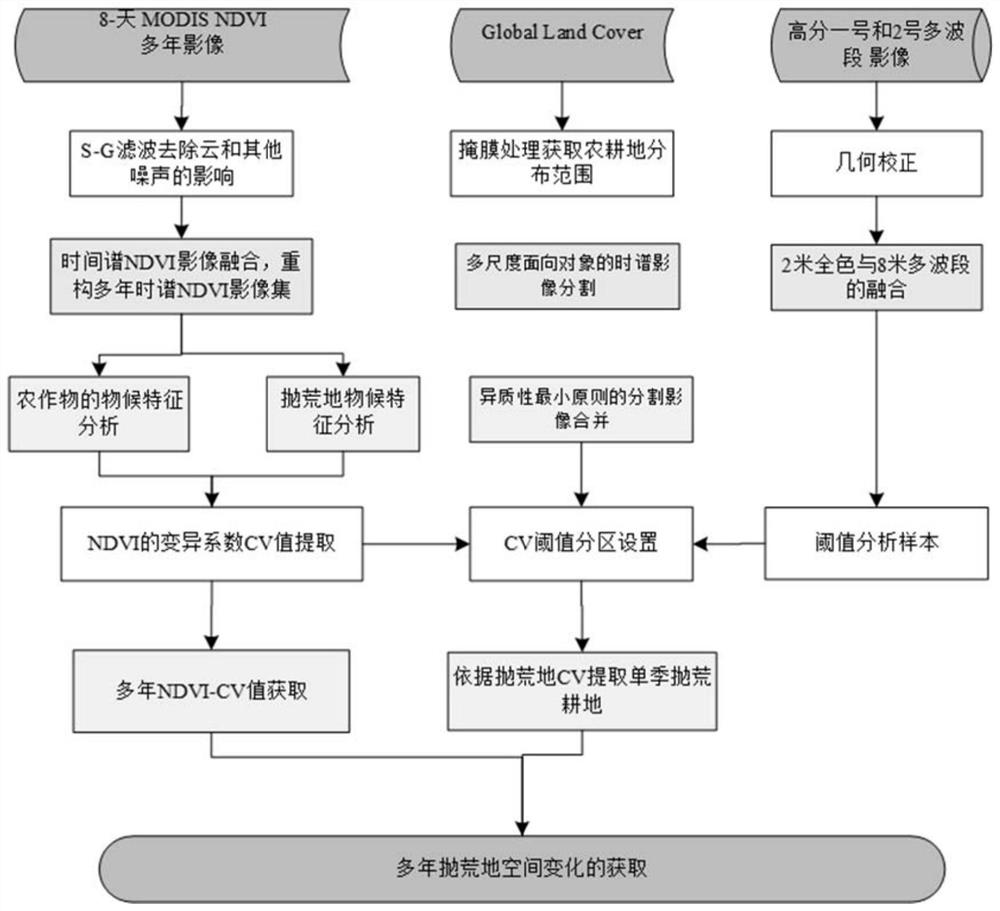Remote sensing time sequence analysis-based abandoned land information extraction method and device
A technology of time series analysis and information extraction, applied in the field of abandoned land detection, it can solve the problems of discontinuous image time series and inability to obtain information on the distribution of abandoned abandoned land during the year, and achieve the effect of reducing spectral resolution requirements, high accuracy and high stability
- Summary
- Abstract
- Description
- Claims
- Application Information
AI Technical Summary
Problems solved by technology
Method used
Image
Examples
Embodiment 1
[0035] This embodiment provides a method for extracting abandoned land information based on remote sensing time series analysis, which overcomes the discontinuous image time series existing in the existing abandoned land extraction method, the phenological characteristics of abandoned land cannot be completely obtained, and the distribution information of abandoned land within a year cannot be obtained. It is a problem that requires high spectral resolution of remote sensing images.
[0036] It includes the following steps: obtaining remote sensing image information; constructing NDVI (Normalized Difference Vegetation Index, normalized difference vegetation index) time series data set according to the obtained remote sensing image information, and constructing the NDVI continuous time series growth curve of vegetation within the range of cultivated land ; According to the NDVI continuous time-series growth change curve of the vegetation in the range of cultivated land, extract ...
Embodiment 2
[0058] This embodiment provides a method for extracting abandoned land information based on remote sensing time series analysis, which overcomes the discontinuous image time series existing in the existing abandoned land extraction method, the phenological characteristics of abandoned land cannot be completely obtained, and the distribution information of abandoned land within a year cannot be obtained. It is a problem that requires high spectral resolution of remote sensing images.
[0059] Firstly, remote sensing information must be obtained, which includes: 8-day MODIS NDVI multi-year images, GLC (GlobalLand Cover, global land cover product set) and Gaofen-1 and Gaofen-2 multi-band high-spatial resolution images; the Gaofen The No. 1 and No. 2 multi-band high-spatial-resolution images were used to extract the samples set by the threshold value of the model parameters in the abandoned land, as the basis for accurate coverage information of the abandoned land.
[0060] The re...
Embodiment 3
[0080] This embodiment provides a device for extracting wasteland information based on remote sensing time series analysis, which can implement the method for extracting wasteland information based on remote sensing time series analysis described in Embodiment 1. The device includes:
[0081] Remote sensing image acquisition module: used to acquire remote sensing image information;
[0082] NDVI construction processing module: used to construct NDVI time series data sets based on the acquired remote sensing image information, and construct NDVI continuous time series growth curves of vegetation within the range of cultivated land;
[0083] Coefficient of variation module: used to extract the parameter CV of the fluctuation intensity of the annual change curve of NDVI according to the NDVI continuous time-series growth change curve of vegetation within the range of cultivated land;
[0084] Distribution information module: used to extract the spatial distribution information of...
PUM
 Login to View More
Login to View More Abstract
Description
Claims
Application Information
 Login to View More
Login to View More - R&D
- Intellectual Property
- Life Sciences
- Materials
- Tech Scout
- Unparalleled Data Quality
- Higher Quality Content
- 60% Fewer Hallucinations
Browse by: Latest US Patents, China's latest patents, Technical Efficacy Thesaurus, Application Domain, Technology Topic, Popular Technical Reports.
© 2025 PatSnap. All rights reserved.Legal|Privacy policy|Modern Slavery Act Transparency Statement|Sitemap|About US| Contact US: help@patsnap.com



